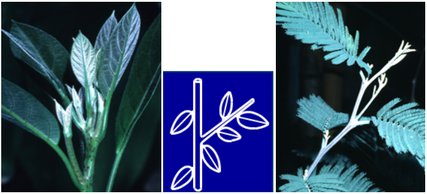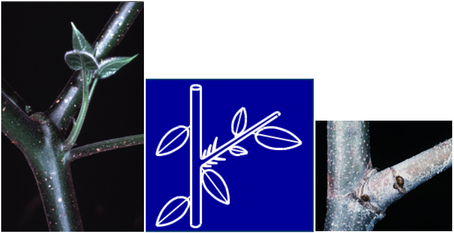Preliminary Course
Botany. Architectural Analysis
Branching delays
The branching event occurrence date is important to consider in the establishment of the ramification structure.
Immediate and delayed branching
-
Morphological traits help in understanding whether the branching process was immediate or delayed in time.
Immediate branching
-
In the case of immediate branching, called sylleptic, the new branched shoot shows a long first internode, i.e. a long hypopodium.
The first leaves of the branched shoot also show a similar type and size then the next leaves, or the bearer leaves.
Lastly, the diameter of the new shoot is often similar to the bared one.
Immediate (or sylleptic) branches result from the development of a newly initiated lateral axis without the apical meristem of that axis having had an intervening rest period.

Immediate branching (Photos and drawing D. Barthélémy, CIRAD)
Left: Persea americana, right: Acacia dealbata
Both first leaves and internodes of the branched shoot are similar to the other ones, and the first internode is long (
Delayed branching
-
In the case of delayed branching, also called proleptic, the new branched shoot usually shows
successive short internodes at its base.
The first leaves of the branched shoot are also reduced when compared to the following leaves, or the bearer leaves.
On the shorter internodes, spines or cataphylls may be found instead of reduced leaves.
And the diameter of the new shoot is usually smaller compared to the bared one.
Proleptic or delayed branches are the result of the discontinuous development of a new lateral axis, with its apical meristem having experienced an intervening period of rest.

Delayed branching (Photos and drawing D. Barthélémy, CIRAD)
On the new shoot, the first internodes are short and bear reduced leaves
Left: On the newly elongated shoot, the diameter is significantly reduced when compared to the bearer (Cyphomandra hartwegii)
Right: Scars on this past branch shows a short hypopodium (Platanus sp)
Note
It may be difficult to define the branching occurrence mode on old past branches.
The observer may come up against the disappearance of morphological marks due to organ pruning and secondary growth.
In such cases, similar younger branching patterns should be considered; and if none are available, destructive wood transverse section analysis may help to retrieve information.
Definition
Hypopodium
Botany. Botanical entity defined on a branch by the portion of stem below the first leaf on a shoot, between the shoot base and the first node.Definition
Syllepsis - Immediate or Sylleptic branches
Botany. Syllepsis is the continuous development of a lateral from a terminal meristem, to establish a branch without an evident intervening period of rest of the lateral meristem. Immediate (or sylleptic) branches lack basal bud-scales and have an extended basal internode (hypopodium) generally below the first leaf or pair of leaves. See also ProllepsisDefinition
Prolepsis, Delayed or Proleptic branches
Botany. Prolepsis is the discontinuous development of a lateral meristem to establish a branch, with some intervening period of rest of the lateral meristem. Delayed (or proleptic) branches have one or more basal bud-scales (often arranged in pairs) and usually with a series of transitional forms (transitional in both size and shape) towards the adult leaf. See also SyllepsisDefinition
